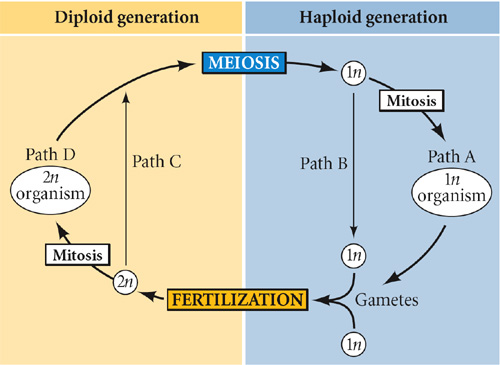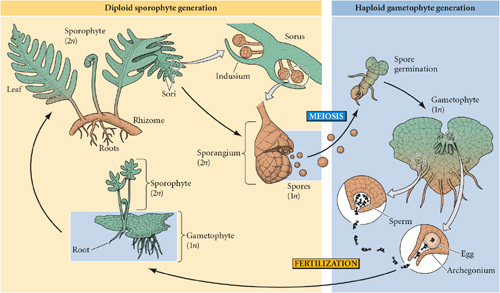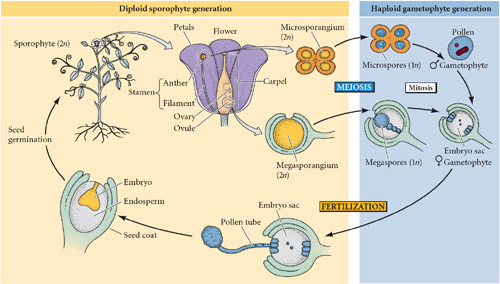Plant Life Cycles
About Plant Life Cycle
In plants, gametes develop in the multicellular haploid gametophyte (Greek phyton, “plant”). Fertilization gives rise to a multicellular diploid sporophyte, which produces haploid spores via meiosis. This type of life cycle is called a haplodiplontic life cycle (Figure 1). It differs from the diplontic life cycle of most animals, in which only the gametes are in the haploid state. In haplodiplontic life cycles, gametes are not the direct result of a meiotic division. Diploid sporophyte cells undergo meiosis to produce haploid spores. Each spore then goes through mitotic divisions to yield a multicellular, haploid gametophyte. Mitotic divisions within the gametophyte are required to produce the gametes. The diploid sporophyte results from the fusion of two gametes. Among the Plantae, the gametophytes and sporophytes of a species have distinct morphologies (in some algae they look alike). How a single genome can be used to create two unique morphologies is an intriguing puzzle.
 Fig. 1: Plants have haplodiplontic life cycles that involve mitotic divisions (resulting in multicellularity) in both the haploid and diploid generations (paths A and D). Most animals are diplontic and undergo mitosis only in the diploid generation (paths B and D). Multicellular organisms with haplontic life cycles follow paths A and C.
Fig. 1: Plants have haplodiplontic life cycles that involve mitotic divisions (resulting in multicellularity) in both the haploid and diploid generations (paths A and D). Most animals are diplontic and undergo mitosis only in the diploid generation (paths B and D). Multicellular organisms with haplontic life cycles follow paths A and C. The “leafy” moss you walk on in the woods is the gametophyte generation of that plant (Figure 2). Mosses are heterosporous, which means they make two distinct types of spores; these develop into male and female gametophytes. Male gametophytes develop reproductive structures called antheridia (singular, antheridium) that produce sperm by mitosis. Female gametophytes develop archegonia (singular, archegonium) that produce eggs by mitosis. Sperm travel to a neighboring plant via a water droplet, are chemically attracted to the entrance of the archegonium, and fertilization results.1 The embryonic sporophyte develops within the archegonium, and the mature sporophyte stays attached to the gametophyte. The sporophyte is not photosynthetic. Thus both the embryo and the mature sporophyte are nourished by the gametophyte. Meiosis within the capsule of the sporophyte yields haploid spores that are released and eventually germinate to form a male or female gametophyte.
 Fig. 2: Life cycle of a moss (genus Polytrichum). The sporophyte generation is dependent on the photosynthetic gametophyte for nutrition. Cells within the sporangium of the sporophyte undergo meiosis to produce male and female spores, respectively. These spores divide mitotically to produce multicellular male and female gametophytes. Differentiation of the growing tip of the gametophyte produces antheridia in males and archegonia in females. The sperm and eggs are produced mitotically in the antheridia and archegonia, respectively. Sperm are carried to the archegonia in water droplets. After fertilization, the sporophyte generation develops in the archegonium and remains attached to the female gametophyte.
Fig. 2: Life cycle of a moss (genus Polytrichum). The sporophyte generation is dependent on the photosynthetic gametophyte for nutrition. Cells within the sporangium of the sporophyte undergo meiosis to produce male and female spores, respectively. These spores divide mitotically to produce multicellular male and female gametophytes. Differentiation of the growing tip of the gametophyte produces antheridia in males and archegonia in females. The sperm and eggs are produced mitotically in the antheridia and archegonia, respectively. Sperm are carried to the archegonia in water droplets. After fertilization, the sporophyte generation develops in the archegonium and remains attached to the female gametophyte. Ferns follow a pattern of development similar to that of mosses, although most (but not all) ferns are homosporous. That is, the sporophyte produces only one type of spore within a structure called the sporangium (Figure 3). A single gametophyte can produce both male and female sex organs. The greatest contrast between the mosses and the ferns is that both the gametophyte and the sporophyte of the fern photosynthesize and are thus autotrophic; the shift to a dominant sporophyte generation is taking place.
 Fig. 3: Life cycle of a fern (genus Polypodium). The sporophyte generation is photosynthetic and is independent of the gametophyte. The sporangia are protected by a layer of cells called the indusium. This entire structure is called a sorus. Meiosis within the sporangia yields a haploid spore. Each spore divides mitotically to produce a heart-shaped gametophyte, which differentiates both archegonia and antheridia on one individual. The gametophyte is photosynthetic and independent, although it is smaller than the sporophyte. Fertilization takes place when water is available for sperm to swim to the archegonia and fertilize the eggs. The sporophyte has vascular tissue and roots; the gametophyte does not.
Fig. 3: Life cycle of a fern (genus Polypodium). The sporophyte generation is photosynthetic and is independent of the gametophyte. The sporangia are protected by a layer of cells called the indusium. This entire structure is called a sorus. Meiosis within the sporangia yields a haploid spore. Each spore divides mitotically to produce a heart-shaped gametophyte, which differentiates both archegonia and antheridia on one individual. The gametophyte is photosynthetic and independent, although it is smaller than the sporophyte. Fertilization takes place when water is available for sperm to swim to the archegonia and fertilize the eggs. The sporophyte has vascular tissue and roots; the gametophyte does not. Fig. 4: Life cycle of an angiosperm, represented here by a pea plant (genus Pisum). The sporophyte is the dominant generation, but multicellular male and female gametophytes are produced within the flowers of the sporophyte. Cells of the microsporangium within the anther undergo meiosis to produce microspores. Subsequent mitotic divisions are limited, but the end result is a multicellular pollen grain. The megasporangium is protected by two layers of integuments and the ovary wall. Within the megasporangium, meiosis yields four megaspores—three small and one large. Only the large megaspore survives to produce the embryo sac. Fertilization occurs when the pollen germinates and the pollen tube grows toward the embryo sac. The sporophyte generation may be maintained in a dormant state, protected by the seed coat.
Fig. 4: Life cycle of an angiosperm, represented here by a pea plant (genus Pisum). The sporophyte is the dominant generation, but multicellular male and female gametophytes are produced within the flowers of the sporophyte. Cells of the microsporangium within the anther undergo meiosis to produce microspores. Subsequent mitotic divisions are limited, but the end result is a multicellular pollen grain. The megasporangium is protected by two layers of integuments and the ovary wall. Within the megasporangium, meiosis yields four megaspores—three small and one large. Only the large megaspore survives to produce the embryo sac. Fertilization occurs when the pollen germinates and the pollen tube grows toward the embryo sac. The sporophyte generation may be maintained in a dormant state, protected by the seed coat. 



